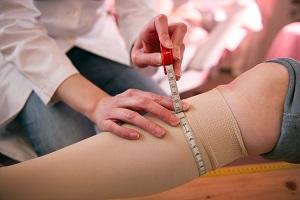Venous Leg Ulcer Management Strategies
January 31, 2019
Venous leg ulcers can be painful, cause distress, and affect quality of life, from the weekly wound center visits, multilayer wraps, debridements, compression hose, elevation of legs above the heart, to the odor from heavy exudate. As chronic venous insufficiency progresses, venous leg ulcers result, with a recurrence rate of 72%.1 The recurrence rate is partly caused by patients who do not adhere to compression therapy.2 The American Journal of Surgery reports that venous leg ulcers account for 85% of all lower extremity ulcers, with treatment costs at $3 billion.3 During the diagnostic workup, the results of tests and examinations will help identify the nature of the problem and severity of the disease and will lead toward the most appropriate plan of care.
Diagnostic tests include Doppler, duplex ultrasound, phlebography, plethysmography, venous pressure measurement, magnetic resonance venography, and computed tomography venography.4 Venous leg ulcers can take a long time to heal, thus making them very costly. Chronic venous insufficiency causes the vein wall to become weak, resulting in incompetent valves. Varicose veins contain high amounts of collagen but low amounts of smooth muscle cells and elastin. This combination is responsible for the disorganization of muscle components, disruption of elastic fibers, and fibrosis.4 When the valves cannot close, the cascade of reflux and pooling begins, progressing to blood leakage though the vein wall. This results in ulcer formation.
Therapeutic Interventions for Venous Leg Ulcers
Compression therapy continues to be the cornerstone of conservative treatment.4 Consistent compression therapy is reported to improve ulcer healing rates, reduce incidence of recurrence, and prolong the time to first recurrence. Between 50% and 60% of patients heal with compression therapy alone during a six-month period.5 Determining a treatment regimen will be driven by many factors: age, overall health and medical history, severity of disease, signs and symptoms, tolerance for treatments, and the patient's preference.5–7
- Intermittent pneumatic compression (IPC) – a mechanical method of delivering compression therapy using an air pump to inflate and deflate an airtight bag wrapped around the leg
- Compression bandages – short stretch, long stretch, multilayer
- Compression stockings
- Debridement methods
- Medications – aspirin, pentoxifylline, diuretics, anticoagulation therapy
- Ultrasound therapy
Venous Ulcer Management
There are various basic treatment strategies recommended for patients with chronic venous insufficiency. Chronic venous insufficiency is more likely to be treatable in the early stages. The goals of these strategies are to prevent pooling of blood and thereby to prevent venous ulcers.6,8,9 Venous leg ulcer management strategies include:
- Maintain a healthy weight.
- Wear compression as ordered by your physician.
- Elevate legs above the heart.
- Avoid crossing your legs.
- Limit salt intake.
- Increase activity.
- Avoid long periods of time standing or sitting.
- Avoid tight clothing and high heels.
- Moisturize skin.
- Stop smoking.
- Practice good skin hygiene.
Compliance
The primary cause of venous ulcer recurrence is non-compliance. Non-compliance has been reported to result from a combination of reasons and continues to be a problem in managing venous leg ulcer management and recurrence. Data show the wide range of reasons and concerns for non-compliance in patients with chronic venous insufficiency.2 Common reasons for patient non-compliance include the following:
- Physical or lifestyle restriction imposed by daily wear of compression garments.
- Poor education or communication delivered by physician or clinician. However, it has been shown that patient education is unlikely to be of benefit in this subset.
- Hot weather.
- Pain and tightness.
- Work-related issues.
- Inability to apply compression garment.
- Cost.
- Cosmetic issues.
- Lack of discipline.
- Ineffectiveness.
Conclusion
Venous ulcer management is designed to heal most ulcers, but gaps in education and compliance hinder this goal set. Patients need not only to be educated, but also to be frequently monitored in an effort to provide consistent venous ulcer management. However, this is not always possible. Compression therapy, debridement, topical agents, absorbent dressings, cellular therapies, and surgery are all part of the wound healing regimen for venous ulcer management.
References
1. Nelzen O, Bergqvist D, Lindhagen A. Venous and non-venous leg ulcers: clinical history and appearance in a population study. Br J Surg. 1994;81(2):182–7.
2. Raju S, Hollis K, Neglen P. Use of compression stockings in chronic venous disease: patient compliance and efficacy. Ann Vasc Surg. 2007;21(6):790–5.
3. Ross DS. Venous stasis ulcers: a review. Northeast Florida Med. 2012;63(2):29–33.
4. Travers JP, Brookes CE, Evans J, et al. Assessment of wall structure and composition of varicose veins with reference to collagen, elastin and smooth muscle content. Eur J Vasc Endovasc Surg. 1996;11(2):230–7.
5. Goldman RJ . 5 things you should know about: compression therapy. Adv Skin Wound Care. 2003:16(4):172.
6. Weller CD, Buchbinder R, Johnston RV. Interventions for helping people adhere to compression treatments to aid healing of venous leg ulcers. Cochrane Database Syst Rev. 2016;3:CD008378.
7. Wittens C, Davies AH, Bækgaard N, et al. Editor's choice: management of chronic venous disease clinical practice guidelines of the European Society for Vascular Surgery (ESVS). Eur J Vasc Endovasc Surg. 2015;49(6):678–737.
8. Livingston M, Wolvos T. Scottsdale Wound Management Guide: A Comprehensive Guide for the Wound Care Clinician. 2nd ed. Malvern, PA: HMP Communications ; 2015.
9. NYU Langone Health . Lifestyle changes for venous insufficiency. https://nyulangone.org/conditions/chronic-venous-insufficiency-in-adult…. 2018. Accessed December 30, 2018.
The views and opinions expressed in this blog are solely those of the author, and do not represent the views of WoundSource, HMP Global, its affiliates, or subsidiary companies.












Follow WoundSource
Tweets by WoundSource